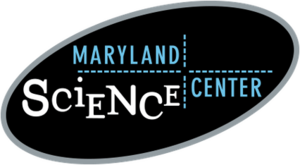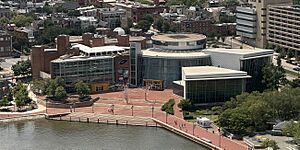Maryland Science Center facts for kids
 |
|
 |
|
| Established | June 1976 |
|---|---|
| Location | Baltimore, Maryland U.S. |
| Type | Science museum |
| Public transit access | Camden Station |
The Maryland Science Center (MSC) is a super cool place in Baltimore's Inner Harbor. It first opened its doors in 1976. This center has three floors packed with fun exhibits, a special planetarium to explore space, and an observatory for looking at the stars.
The Science Center was one of the first big projects that helped make Baltimore's Inner Harbor a popular spot. Before, it was mostly industrial. In 1987, a giant IMAX movie theater was added. The center got a big update in May 2004. Now, it has modern, hands-on exhibits, including more than 24 dinosaur skeletons! You can learn about physical science, outer space, and even the human body here.
The Maryland Science Center is located near the Key Highway. It's also close to the historic Federal Hill Park and Robert Baker Park. In 2006, the center won a "Best Place to Take Kids" award from Best of Baltimore. Then, in 2008, Parents magazine named it one of the "10-Best Science Centers for Families."
Contents
- Awesome Exhibits to Explore
- Dinosaur Mysteries: Meet Ancient Giants
- Newton's Alley: Play with Physics
- Science & Main: Build and Fly
- Science Aglow: Light Up Your World
- You – The Inside Story: Discover Your Body
- SciLab: Experiments for Young Scientists
- Our Place in Space: Journey Through the Cosmos
- Power Up: Energy All Around Us
- Math in Nature: Nature's Numbers
- The Kids Room: Fun for Little Explorers
- The Shed: Create and Invent
- The Demonstration Stage: Live Science Shows
- SpaceLink: Your Space News Hub
- Gallery
- Awards and Scholarships for Maryland Residents
Awesome Exhibits to Explore
The Maryland Science Center has many exciting exhibits. Each one lets you learn about science in a fun, hands-on way.
Dinosaur Mysteries: Meet Ancient Giants
This exhibit takes you back in time! You can see life-size models of two dinosaurs: Astrodon and Acrocanthosaurus. Astrodon is even Maryland's state dinosaur! There are also full-size skeletons of other huge dinosaurs like Giganotosaurus and Tyrannosaurus. You can even pretend to be a paleontologist and dig for an Iguanodon skeleton.
Newton's Alley: Play with Physics
In Newton's Alley, you get to try out cool science tricks. This area focuses on physical science. You can experiment with things like a "Bernoulli blower" and an "inertia table." It's all about how things move and react!
Science & Main: Build and Fly
Here, you can solve challenges and learn about physics. You might get to fly a paper airplane or build amazing structures with large blocks. It's a great place to be creative and see science in action.
Science Aglow: Light Up Your World
This exhibit lets you play with light! You can do experiments with optics and the physics of light. Discover how light works and what it can do.
You – The Inside Story: Discover Your Body
Ever wondered what's happening inside you? This exhibit shows you how your human body works. You can learn about your senses. There's even a bed of nails you can try out safely!
SciLab: Experiments for Young Scientists
SciLab is a special laboratory just for kids aged 8 to 9. Here, you can put on a lab coat and do your own science experiments. It's a perfect place to feel like a real scientist!
Our Place in Space: Journey Through the Cosmos
Blast off into space in this exhibit! You'll learn about our Solar System, our galaxy, and the whole universe. It features a cool technology called Science on a Sphere, designed by NOAA. Live shows about Earth and space happen daily on this sphere. The Davis Planetarium is also part of this amazing space journey.
Power Up: Energy All Around Us
This exhibit shows you how electric energy is used every day. You'll see how electricity powers our homes and devices.
Math in Nature: Nature's Numbers
Discover how nature uses math in surprising ways. This exhibit has interactive activities that show you the math behind plants, animals, and natural patterns.
The Kids Room: Fun for Little Explorers
This room is designed for children aged 8 and younger and their families. It has a water table, a pretend ship, and other fun activities for younger kids to enjoy.
The Shed: Create and Invent
The Shed is a "Do It Yourself" workshop. Visitors can come here to create all sorts of inventive objects. It's a great spot to build and design!
The Demonstration Stage: Live Science Shows
Head to the Demo Stage for exciting live science shows! You can see demonstrations about inertia, static electricity, liquid nitrogen, and amazing chemical reactions. They also cover combustion reactions and space technology.
SpaceLink: Your Space News Hub
The SpaceLink exhibit keeps you updated on the latest news from space. You can ask staff questions about upcoming satellite missions and much more.
Gallery
Awards and Scholarships for Maryland Residents
The Maryland Science Center also celebrates amazing scientific work. Each year, they give out special scholarships and awards to talented people living in Maryland. These include:
- Dr. H. Bently Glass Scholarship
- Maryland’s Outstanding Young Scientist Award
- Maryland’s Outstanding Young Engineer Award
- Maryland’s Outstanding STEM Educator Award




